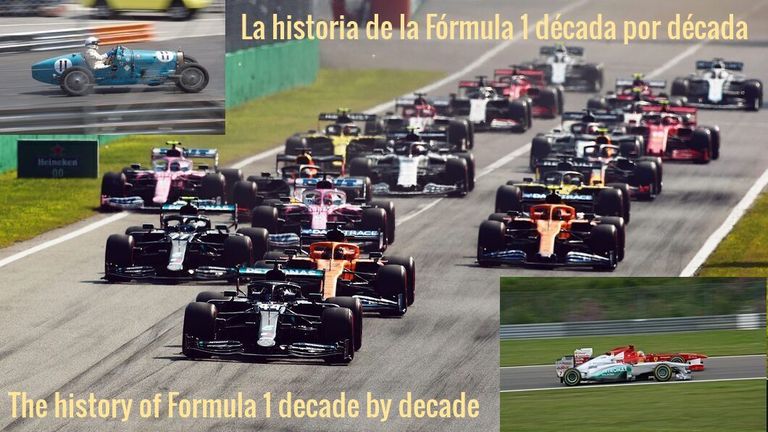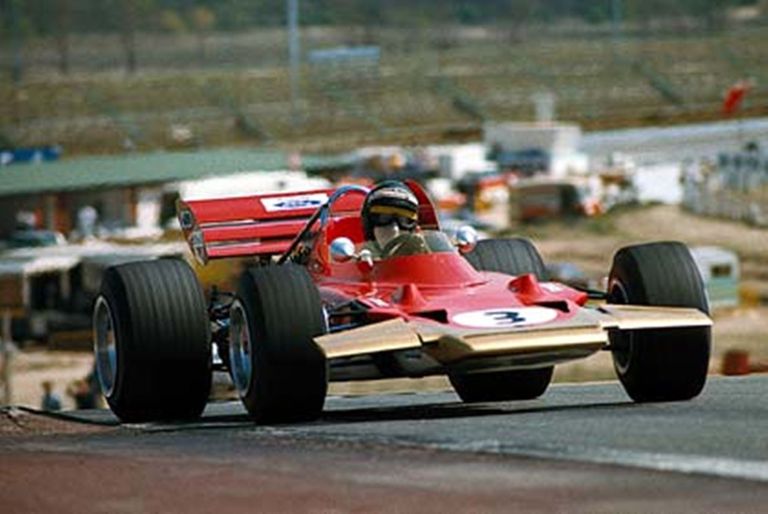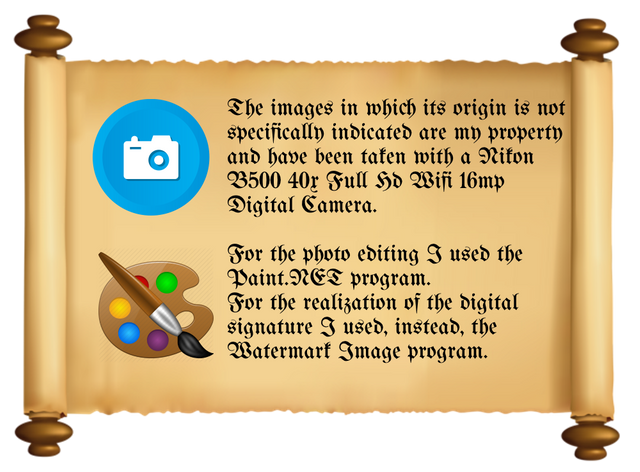
75 años de pasión deportiva, dramas y glorias, la historia de la Fórmula1 contada por décadas. /75 years of sporting passion, dramas and glories, the history of Formula 1 told by decades.
Sigo con una nueva entrega dedicada al historial de la Fórmula 1 apreciada comunidad deportiva de @fulldeportes, una trayectoria que trae a nuestra memoria emociones, títulos y grandes campeones analizada década por década.
Me vino a la mente publicar esta serie de "recordatorios"porque en el año 2022 se cumplirá el 75° Aniversario de la creación Fórmula 1, aunque en realidad las carreras comenzaron a disputarse -representando a la FIAì reción en 1950.
Tres cuartos de siglo a través de los cuáles han desfilado grandes campeones y grandes equipos, grandes alegrías, sorpresas, rivalidades y también grandes desilusiones.
En el primer post les hablé del predominio italiano fuerte de su experiencia anterior, con autos que ya se venían probando desde hacía bastante tiempo atrés como el Alfa Romeo de Nino Farina, el primer campeón mundial, que ya tenía trece años de desarrollo.
La segunda década en cambio vio protagonistas a los británicos que, dejada de lado la sorpresa inicial, comenzaron a desarrollar nuevos modelos y motores que compitieron en igualdad de condiciones con los italianos, a poyados por la fábrica francesa Matra que comenzó a producir tal vez el mejor motor de la Fórmula 1 de todos los tiempos, el Cosworth utilizado, en otros, por el equipo Lotus.
Llegamos de esta manera a la tercera década (1971-1980), con una categoría automovilística que, ya a estas alturas, con más de veinte años de experiencia, prometía una lucha más aguerrida entre marcas y pilotos.

I continue with a new installment dedicated to the history of Formula 1, dear sports community of @fulldeportes, a trajectory that brings back emotions, titles and great champions analyzed decade by decade.
It came to my mind to publish this series of "reminders" because the year 2022 will mark the 75th anniversary of the creation of Formula 1, although in reality the races began to be held - representing the FIA - in 1950.
Three quarters of a century through which great champions and great teams have paraded, great joys, surprises, rivalries and also great disappointments.
In the first post I told you about the strong Italian dominance of its previous experience, with cars that had already been tested for a long time, such as the Alfa Romeo of Nino Farina, the first world champion, which was already thirteen years in development.
The second decade, on the other hand, saw the British as protagonists who, after the initial surprise, began to develop new models and engines that competed on equal terms with the Italians, supported by the French factory Matra, which began to produce perhaps the best Formula 1 engine of all time, the Cosworth used, among others, by the Lotus team.
Thus we reach the third decade (1971-1980), with an automobile category that, by now, with more than twenty years of experience, promised a fiercer fight between brands and drivers.
Una década caracterizada por la falta de un claro dominador. / A decade characterized by the lack of a clear dominator.

Niki Lauda alcanza su primer título de campeón del mundo con una pole position y una victoria en el Gran Premio de Estados Unidos.
Terminanda la dominación de la llamada "era Lotus" con sus estupendos y revolucionarios modelos Lotus 72 y Lotus 79 que consagraron campeón a Jim Clark en dos ocasiones (1963 y 1965), a Graham Hill en 1968 y a Jochen Rindt en las postrimerías de la década anterior (1970) los autos cambian completamente y en el arco de un decenio son modificados totalmente.
Por ejemplo, a instancias de Jackie Stewart y luego de la muerte de Jochen Rindt, son implementados el cinturón de seguridad, el traje antifuego y el casco integral. Elementos que poco años más tarde salvaron la vida a Niki Lauda en el espantoso accidente que sufrió en el circuito de Nürburgring en 1976.
Tal vez a nivel de pilotos haya coincidencia en remarcar el predominio de Emerson Fittipaldi con los dos títulos mundiales ganados en 1972 y 1974 primero con Lotus Ford y luego con McLaren Ford o de Niki Lauda en 1975 y 1977 con Ferrari.
Los restantes campeonatos fueron a Jackie Stewart con Tyrrel Ford en 1971 que repite en 1973 pero con Lotus.
A este punto tenemos tres pilotos (Fittipaldi, Stewart y Lauda) que ganan dos títulos cada uno, los restantes cuatro van a parar a las manos del británico James Hunt con Ferrari en 1976, del estadounidense Mario Andretti con Lotus en 1978, el sudafricano Jody Scheckter en 1979 nuevamente con Ferrari, y el australiano Alan Jones con el nuevo equipo Williams en 1980 cerrando la década.
En esta década, todavía la mayor parte de los equipos eran de origen europeo salvo algunas esporádicas incursiones de teams estadounidenses.
A fin de esta década nace un conflicto que más que deportivo fue económico: el nacimiento de la FISA (Fédération Internationale du Sport Automobile) presidida por Jean-Marie Balestre que se oponía a la FOCA (Formula One Constructors Association) en manos de Bernie Ecclestone, por el control de los derechos televisivos.
Ya la Fórmula 1 comenzaba a ser un enorme business.

After the domination of the so-called "Lotus era" with its stupendous and revolutionary Lotus 72 and Lotus 79 models, which made Jim Clarks champion on two occasions (1963 and 1965), Graham Hill in 1968 and Jochen Rindt champion at the end of the previous decade (1970), the cars changed completely and within a decade they were totally modified.
For example, at the request of Jackie Stewart and after the death of Jochen Rindt, the seat belt, the fireproof suit and the full-face helmet were implemented. Elements that a few years later saved Niki Lauda's life in the dreadful accident he suffered at the Nürburgring in 1976.
Perhaps at driver level there is a coincidence in highlighting the predominance of Emerson Fittipaldi with the two world titles won in 1972 and 1974, first with Lotus Ford and then with McLaren Ford, or of Niki Lauda in 1975 and 1977 with Ferrari.
The remaining championships went to Jackie Stewart with Tyrrel Ford in 1971 who repeated in 1973 but with Lotus.
At this point we have three drivers (Fittipaldi, Stewart and Lauda) who win two titles each, the remaining four go to the British James Hunt with Ferrari in 1976, the American Mario Andretti with Lotus in 1978, the South African Jody Scheckter in 1979 again with Ferrari, and the Australian Alan Jones with the new Williams team in 1980 closing the decade.
In this decade, most of the teams were still of European origin except for some sporadic incursions of American teams.
At the end of this decade, a conflict was born that more than sporting was economic: the birth of FISA (Fédération Internationale du Sport Automobile) presided by Jean-Marie Balestre, who opposed FOCA (Formula One Constructors Association) in the hands of Bernie Ecclestone, for the control of television rights.
Formula 1 was already becoming a huge business.

Un exultante Emerson Fittipaldi gana el Gran Premio de España en Jarama en 1972 e inicia a construir lo que sería su primer título mundial. / An ecstatic Emerson Fittipaldi wins the Spanish Grand Prix at Jarama in 1972 and begins to build on what would be his first world title.
Hasta el momento del accidente de Niki Lauda el aspecto externo y de seguridad de los autos no había cambiado demasiado a los de la década anterior. Las cajas de aire que sobresalían por encima de las cabezas de los pilotos eran gigantescas, los alerones salín siempre del morro aunque con distintas formas y la única novedad en el aspecto externo y motriz de los monoplazas fue la revolucionaria adopción de las seis ruedas en el Tyrrell P34.
Que, de cualquier manera, no tuvo ni una vida demasiado larga ni resultaron que favorecieran las expectativas. El reglamento de la FIA era bastante elástico al respecto.
Con respecto a la parte motorística la mayor innovación la introdujo Ferrari con la caja de cambios transversal que permitía una mejor redistribución del peso en el eje trasero y que le permitió a la casa de Maranello de ganar tres Campeonatos de Constructores seguidos, en los años 1975, 1976 y 1977 ganados también por Lauda a excepción del 1976 cuando fue superado por Hunt.
Hacia fines de la década la ausencia de un reglamento en la FIA que definiera específicamente algunos aspectos en los motores dio origen a una de las mayores controversias: los motores sobrealimentados técnicamente llamados "trubocompresores". Lotus y Renault fueron los primeros en partir con la novedad en el año 1977 y Lotus recogió en seguida los frutos con Mario Andretti ganando el Mundial de Pilotos un año más tarde.
Si bien los motores sobrecargados existían ya desde hacía años ningún equipo había querido utilizarlos hasta el momento por el miedo a un excesivo consumo de carburante.
En Renault, por ejemplo, los problemas se revelaron no desde el punto de vista del consumo del carburante sino de la fragilidad de los motores y las continuas roturas que recién pudieron ser solucionadas en 1979.
Lotus también sufrió problemas de roturas con esos motores pero el efecto aerodinámico ventajoso que consiguió le permitió a Mario Andretti ganar el Mundial de Pilotos con el Lotus 79.
Y asi entre una lucha que se preanunciaba inmimente entre la FISA y la FOCA por los derechos televisivos de la Fórmula 1 nos encaminamos hacia la cuarta década en la historia de la Fórmula 1, entre 1980 y 1990.

Up to the moment of Niki Lauda's accident, the external and safety aspect of the cars had not changed much from those of the previous decade. The airboxes that protruded above the drivers' heads were gigantic, the ailerons always came out of the nose although in different shapes and the only novelty in the external and motor aspect of the single-seaters was the revolutionary adoption of the six wheels in the Tyrrell P34.
Which, in any case, had neither too long a life nor did they live up to expectations. The FIA regulations were quite elastic in this respect.
Regarding the engine part, the greatest innovation was introduced by Ferrari with the transverse gearbox that allowed a better redistribution of weight on the rear axle and that allowed the Maranello house to win three Constructors' Championships in a row, in 1975, 1976 and 1977, won also by Lauda, except for 1976 when he was overtaken by Hunt.
Towards the end of the decade, the absence of an FIA regulation that specifically defined some aspects of the engines gave rise to one of the biggest controversies: the supercharged engines, technically known as "trubocompressors". Lotus and Renault were the first to start with the novelty in 1977 and Lotus soon reaped the rewards with Mario Andretti winning the Drivers' World Championship a year later.
Although supercharged engines had been around for years, no team had wanted to use them until then for fear of excessive fuel consumption.
At Renault, for example, the problems were revealed not from the point of view of fuel consumption, but from the fragility of the engines and the continuous breakages that could only be solved in 1979.
Lotus also suffered problems with these engines, but the advantageous aerodynamic effect they achieved allowed Mario Andretti to win the Drivers' World Championship with the Lotus 79.
And so, in the midst of an imminent fight between FISA and FOCA for the television rights of Formula 1, we headed towards the fourth decade in the history of Formula 1, between 1980 and 1990.

No obstante el carácter revolucionario de la innovación el Tyrrell P34 con 6 ruedas tuvo poco éxito y la idea fue abandonada después de poco tiempo. / However the revolutionary nature of the innovation the 6-wheel Tyrrell P34 had little success and the idea was abandoned after a short time.



Gracias por leer. / Thank you for reading.
Los enlaces de mis sitios web / Links to my websites :

Upvoted. Thank You for sending some of your rewards to @null. Get more BLURT:
@ mariuszkarowski/how-to-get-automatic-upvote-from-my-accounts@ blurtbooster/blurt-booster-introduction-rules-and-guidelines-1699999662965@ nalexadre/blurt-nexus-creating-an-affiliate-account-1700008765859@ kryptodenno - win BLURT POWER delegationNote: This bot will not vote on AI-generated content
Thanks!